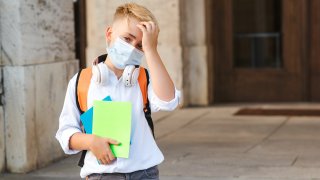

The following content is created in partnership with Stanford Children’s Health. It does not reflect the work or opinion of the NBC Bay Area editorial staff. Click here to learn more about Stanford Children’s Health.
With children back to in-person school, parents are naturally concerned about the risks of COVID on their children’s physical health. But they also may be worried about the emotional toll this may have on children. And with good reason: Going back to classes during the pandemic can indeed give children anxiety, for a number of unique reasons.
Here is some guidance from Mari Kurahashi, MD clinical associate professor at the Stanford School of Medicine’s Child Psychiatry Division and co-director of the Stanford Parenting Center at Stanford Children’s Health.
Traditional back-to-school anxiety vs. post-COVID back-to-school anxiety
“As children return to school, most children experience a mixed combination of nerves and excitement for the new school year,” Kurahashi says.
Children wonder about things like, What will this schoolyear be like? Who's going to be in my class? Who's going to be my teacher? And then there’s the adjustment from being off for the summer and then going back to school.”
With the ongoing pandemic, most children will adapt back to in-person school smoothly, yet some children may have additional worries—concerns about being in close proximity with classmates and regarding which interactions are safe, she says. Also, they’re managing social dynamics again, feeling insecure about learning among their peers, and being away from their family.
Kids interacting with other kids
Schools may have rules dictating social distancing. But enforcement all day can be tough—especially before and after school. So how do parents manage how their children socialize with others?
“That's a family decision informed by public health guidelines,” Kurahashi says. “Children need social interactions for their well-being, as do parents, so it’s important to support children’s social lives while balancing the need to keep families and their communities safe.
Get a weekly recap of the latest San Francisco Bay Area housing news. Sign up for NBC Bay Area’s Housing Deconstructed newsletter.
“Some parents will keep children within their trusted ‘pods,’” Kurahashi continues. “Or, if infection numbers are low and families are following safety guidelines, parents may be okay with letting their children get in closer proximity. Some children will be rusty with their social skills or may experience shyness and have difficulty making friends as they adjust back to school. Parents can help facilitate outdoor play dates to support friendships and social connection. Having a friend in their class can significantly help a child feel less nervous about attending school. Parents can also sign up their children for extracurriculars and make friends with children who have similar interests.”
Leaving remote learning behind
While remote learning was challenging for some kids, “Some children thrived with distance learning. It was a nice break from the day-to-day and social pressures,” Kurahashi says. She adds that some children with learning challenges and ADHD may need some time to go from learning at their own pace to adjusting to back to in-person learning with their peers. Many children also fell behind in school due to distance-learning. Parents can check in with the teacher on how their child is doing and make sure the child is getting appropriate academic supports.
Signs for parents to look out for
So how might anxiety in kids reveal itself? Children may seem more clingy, fussy, and tearful—especially younger children, Kurahashi notes. And preteens may seem more fatigued, isolated, and moody.
“Parents need to pay attention if these symptoms persist for weeks or months, and it’s impacting their ability to be in school or if they are withdrawing from activities they usually enjoy,” Kurahashi says. They may need professional support. Schools can also be a great resource for helping support children.”
Kurahashi adds, “Children often don't have a lot of great insight into their anxiety, so it may not be communicated verbally but expressed in different behaviors. It's rare for a child to say, ‘This transition back to school is causing me a lot of anxiety, you know?’ So it is important for parents to be aware of concerning signs and observe their children.
When COVID hits too close to homeroom
Many parents wonder what will happen this school year and hope no one in their child’s class tests positive for COVID. “Before that happens, let them know everyone is working very hard to keep them safe at school and that the child is keeping themselves safe by wearing a mask, following the school rules around social distancing and hand washing,” Kurahashi says. “You can let them know it's still possible that one of their classmates might test positive and if that happens, here's what the school’s rules are around that to keep others safe. ‘You'll get tested. You'll be home for a certain number of days so that we can make sure everyone else stays safe.’ This way, they are prepared and it's not such a surprise for them.”
Not being the source of kids' anxiety
Sometimes, the parents are the nervous ones: They’re worried about sending their kids back to school amidst the uncertainty of COVID. “Anxiety can be contagious,” Kurahashi says, “It’s critical that parents find even brief moments to take care of their physical and emotional health to support their children. With limited time, parents can call a friend, go for a walk, take some mindful breaths. Modeling emotion labeling and healthy coping skills is one of the most important ways that parents can support their child.”
Stanford Children’s Health supports a full care team to help kids’ deal with mental health issues. Click here to see Stanford’s services.

